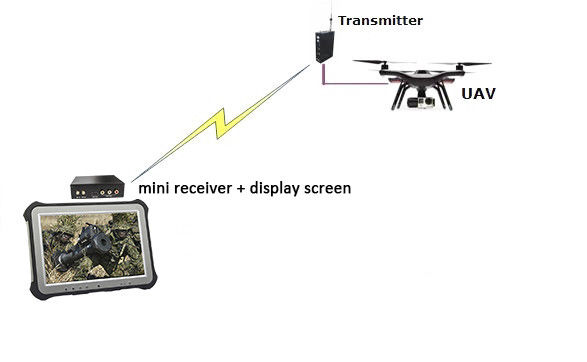COFDM Delivers Combined Military Surveillance and IP Data Links Leave a comment
Military Surveillance demands high capacity, secure and robust data links
to deliver the multiple, high definition real time images available from the sensors of modern surveillance platforms. range requirements vary from tactical assets needing only 4-5 km through to long-range patrol surveillance systems demanding capability at least to the radio horizon.
Traditional VHF/UHF systems have provided low data rates for voice and highly compressed imagery. Satellite communications provide Beyond Line of Sight (BLoS) capabilities, but are severely capacity limited by virtue of both their cost and availability. Traditional military and commercial microwave Line of Sight (LoS) data links can be infrastructure independent and have been suitable for tactical ranges and for urban surveillance if utilizing suitable waveforms. A typical application of standard microwave LoS links has been to transmit surveillance video from air platforms to the ground.
The latest COFDM data links used for surveillance applications have now evolved.
to include an IP link to the platform combined with the high integrity, high capacity, military grade security and extended range of the latest generation of COFDM based systems. The
‘uplink’ data path may be used to remote control sensors and/or control unmanned systems in the most demanding environments. As surveillance sensors, their platforms and capability have advanced they are now being matched by the capability and flexibility of the latest generation of COFDM microwave links that combine, to best effect, many of the attributes of legacy military data links with the performance of the latest imagery transmission systems. As surveillance sensor platforms become smaller and more pervasive in the battle space, COFDM microwave links are being adopted by those needing to realize the true capability of their sensors that are currently constrained by legacy military communications systems. Enterprise Control Systems (ECS), as an award winning leader in this field, is already supplying a number of key surveillance users with these advanced capabilities.
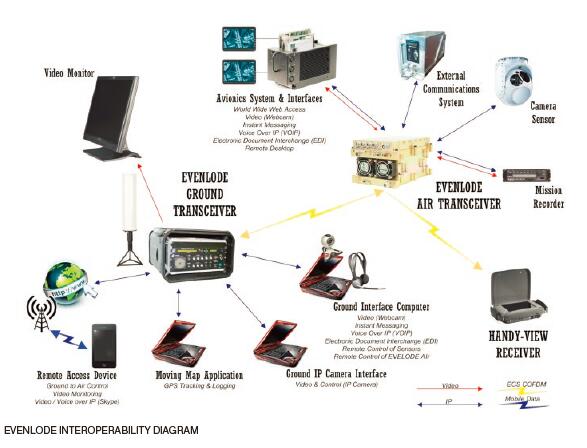
ECS and COFDM
Coded Orthogonal Frequency Division Multiplexing (COFDM) is a spread spectrum radio transmission technique. COFDM splits the data stream over multiple carriers with much slower symbol rate than a single carrier transmission. Using a much lower symbol rate gives resilience to multipath fading. Additionally, coding information is added to the data stream and used at the receiver to estimate the most likely transmitted signal state sequence. Each subcarrier propagates slightly differently and some subcarriers may be lost at a single receive point. Using multiple subcarriers together with diversity antennas provides an extremely robust link far more resilient than a single carrier system. The COFDM scheme is adopted as part of the Digital Video Broadcast – Terrestrial (DVB-T) standard and used to transmit Free view in the UK.
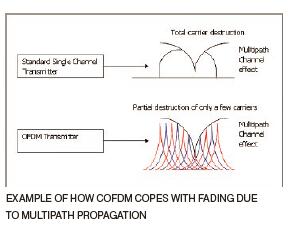
Enterprise Control Systems Ltd (ECS) has since 2003 optimized the DVB-T standard for surveillance use, tuning the implementation to achieve the highest levels of integrity and availability, security and range performance that are essential to the military surveillance task. This advanced ‘militarized’ implementation of the already highly capable COFDM scheme has been delivered to specialist customers since 2004. The robust nature of this link, the intuitive user interfaces provided and the aircraft Certification/type approval for all standard systems are the reasons why over 200 airborne ECS systems are now used for operationally- critical missions in over 40 countries. Continuing advances in techniques and technology coupled with the development of operational concepts and battle space surveillance solutions have now taken these capabilities to another level.
The ECS EVENLODE Data Terminal
EVENLODE is the lightweight data terminal specifically designed to meet the demands of Unmanned Aerial Vehicles (UAV) but equally well suited and employed for other airborne, ground and maritime data applications. A pair of EVENLODE data terminals behaves like an Ethernet cable between networks at either end of the link whilst simultaneously providing 2
High Definition (HD) video streams from the sensor(s). With advanced, flexible and even dynamic configuration control EVENLODE provides an innovative solution for the most demanding information exchange requirements in surveillance systems.
The standard system provides 10 W Radio Frequency (RF) output and has been proven to provide links of up to 200 Nautical Miles (NM) range and, up to 21 Mbps data exchange rate. The system is available in L, S and C radio bands and is DO160 approved for airborne installation. The air equipment, at 3 kg for the standard
10 W system has been designed for UAV and is modular. The standard EVENLODE air data terminal comprises of Transceiver, Power Regulation & Supply, Heat Exchange and, Linear Power Amplifier modules. The modules may be distributed for load balance, or be provided to meet bespoke operational requirements. A separate Video Encoder Module capable of encoding up to two video signals and two audio signals is supplied for direct video and audio input. The Video Encoder Module has 4
High Definition (HD) and 2 Standard Definition
(SD) inputs. Any video input may be selected and switched, including during a mission, as an input to the two video encoders with the configuration and control of the Advanced Video Codec (AVC/H.264/MPEG4 P10) compression parameters also dynamically selectable. As such the Video Encoder Module is offered as a front-end video management system.
The data from the Air Video Encoder Module is
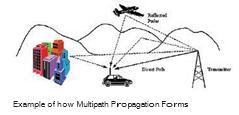
Presented to the transceiver as an Asynchronous Serial Interface (ASI) (MPEG2 P1) along with the Internet Protocol (IP) data and multiplexed onto the Transport Stream. The Transport Steam data is then modulated using a COFDM technique and transmitted. An Internet Protocol (IP) data buffer is incorporated as part of the transceiver module to manage IP data fluctuations that may momentarily exceed the link capacity. So that data is not lost, IP data is buffered at the transmitter section of the transceiver and released as soon as the link is capable of sending the buffer content. IP communication is point-to-point. Critically, for a surveillance asset, the ASI information (in most cases the sensor output) is transmitted omni-directionally to any number of receivers within range, each of which decrypts the signal to view it. In this way the EVENLODE system is predominantly agnostic to the sensor platform orientation or motion and provides a secure data link from the platform to multiple receive sites simultaneously, coupled with an IP link to the platform to deliver any available IP based functionality required.
To manage the trade-off between the available data rate and the link range, an EVENLODE system is provided with the ability to adjust the radio link parameters and optimise them for the surveillance task. The way in which this control is implemented is bespoke to customer, sensor and platform requirements. This control may be based on the assessment of the link range with Global Positioning System (GPS) data sent between the two link data terminals, by user control, by automatic sensing of the required data rate for the information requested to be sent or, by automatic link monitoring between the two data terminals.
EVENLODE ground data terminals may be
provided specific to operational requirements with options for mobile, portable and static .
systems. A majority network voting system may be used to link any number of ground data terminals onto an IP area network backbone. The Network Voting System automatically selects the best receive signal available in the network and uses this to multicast received ASI data securely to any number of monitoring sites. Uplinks from a network voting system are achieved by DVB-T Single Frequency Network (SFN) techniques and transmitting the same signal from every ground data terminal or, selectively by knowledge of the position of the platform.
The EVENLODE System is extremely flexible and can be configured to meet the demands of highly capable surveillance sensor systems. With close human factors analysis of customers’ requirements, Enterprise Control Systems Ltd (ECS) is able to provide intuitive interfaces to EVENLODE systems and provide pre-set profiles for specific operational tasks, or even tighter integration into mission systems.
Fully embedded security is always provided, carefully integrated into these advanced systems so as to work in seamlessly with the complex demands of full motion video communication. Systems are supplied with either integrated Advanced Encryption Standard (AES)
256-bit (subject to export license) or Substitution
Cipher encryption.
Benefits of the Next Generation of COFDM Systems
Internet Protocol (IP) is fast becoming a ubiquitous interconnection standard within all platforms from the individual soldier system, through specialist battlefield vehicles, to ships, to aircraft and unmanned systems. For example Avionics Full Duplex Switched Ethernet (AFDX / ARINC 664 Part 7) is a standard that is replacing bus systems such as ARINC 429 for data exchange requirements on air platforms. It is therefore essential to integrate with these IP data bus systems. Extending the platform IP data bus with an IP communications link that is already embedded within the encrypted COFDM data link from the sensor platform delivers a significant capability gain. The user gets a smaller, lighter, more efficient and substantially less complex system. These performance and capability improvements coupled with reduced size, weight and power consumption are most apparent on the surveillance platform itself, with a lower box/equipment count. However, the system improvement continues to roll out through the receive networks across the large number of potential consumers of the surveillance product, all of whom benefit from the simplicity, the tighter system integration and the increased performance available.
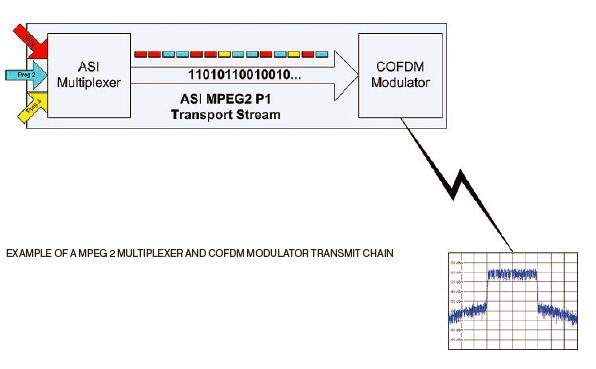
waveforms may effectively be programmed and
‘ported’ onto the soft cores so that EVENLODE may be configured with other waveforms for interoperability. Flexibility, configurability and longevity of use in a demanding and changing battle space will always remain another key aspect to the selection and deployment of mission critical capability.
As the surveillance ‘eyes’ of the battle space play an increasingly critical role in the execution of operations, it makes sense that everyone across multiple domains is able to exploit to best effect what these ‘eyes’ can see. Today’s sensor platforms are increasingly becoming ‘un-tethered’ from their single points of control and single points of product ingest into the battle space. The dissemination of surveillance product direct from the sensor platform to the widest number of potential users, without adding the burden of complex user to user transport has been happening as a quiet revolution for some time. The continued deployment of advanced, COFDM techniques optimized for the military surveillance domain and their combination with platform and networked C2 is adding yet another step- change improvement in the delivery of this vital commodity.
The leading manufacturers of platform Electro Optical (EO) camera turrets continue with the Standard Digital Interface video outputs as their output of choice. These SDI outputs can be encoded and indexed on an MPEG2 P1 Transport Stream and sent as a Constant Bit Rate (CBR) datalink payload. The Transport Stream may be encapsulated with IP and presented onto an IP network using one-directional protocols such as Unidirectional Datagram Protocol (UDP) or, the SDI may be encoded and presented to the IP network without indexing on a Transport Stream using Real Time Protocol (RTP) and a jitter buffer at the receiver. Control of platform sensors is increasingly IP-based. Therefore systems such as EVENLODE provide the ability to control platform sensors remotely over the COFDM link with the ability to send both SDI video via the Video Encoder Module, or any IP based information.
EVENLODE provides a remote IP network link which gives all manner of operational advantages. The EVENLODE link may be used to provide a remote terminal access on the sensor platform into a database or server system. The platform then has access to the server system information such as mapping, operational tasking and intelligence with remote access into this information over the COFDM EVENLODE link. In this way, the storage of sensitive information on the sensor platform is minimized and can be denied should the platform be compromised. The IP link may be used for messaging, transferring files, Video over IP and, to provide ’internet- on-the-platform’. As an example, in the case of manned air surveillance platforms, it is now feasible to relocate the air surveillance sensor operator from the platform, to the controlling, or sensor data consuming node.
COFDM transmission, as a
spread spectrum technique using multiple carriers,
occupies a
significant bandwidth. It is therefore absolutely essential to derive maximum operational benefit from this critical battlefield resource. Payload data rate is proportional to the bandwidth allocated in the available spectrum. Data links are therefore available for frequency ranges between 1 and
6.5 GHz (L, S and C Band). Users are also under pressure to release frequency spectrum to facilitate commercial mobile data services. So, bandwidth is a premium. EVENLODE uses Advanced Video Coded (AVC/H.264/MPEG4
P10) to code sensor video with significant improvements in compression for the same quality image over older legacy encoding techniques such as MPEG 2 P2/H.262. This means that the same quality full motion image may be sent via an EVENLODE link using less bandwidth with the added advantage that lower bandwidth signals are also capable of greater ranges (Thermal noise is proportional
to bandwidth). Incorporating variable bandwidth setting and the AVC codec, allows EVENLODE to provide the optimum link range performance for any data exchange requirement. Enabling expert user control of these parameters in a dynamic manner, even during a mission, enables the user to actively ‘fight’ the system in the RF/cyber/ISTAR domain to maintain operational effectiveness and combat attempts by an opponent to deny it.
The highly optimized ECS COFDM radio spread spectrum technique has been proven on operations in Line of Sight (LoS) and Near-Line of Sight (NLOS) environments, in high multipath environments in the land, maritime and air domains and on air platforms ranging from rotary to fast jets. As waveforms and techniques continue to evolve and standards to emerge, the latest generation EVENLODE system has been designed with interoperability
in mind. Utilizing the soft-core boards.
